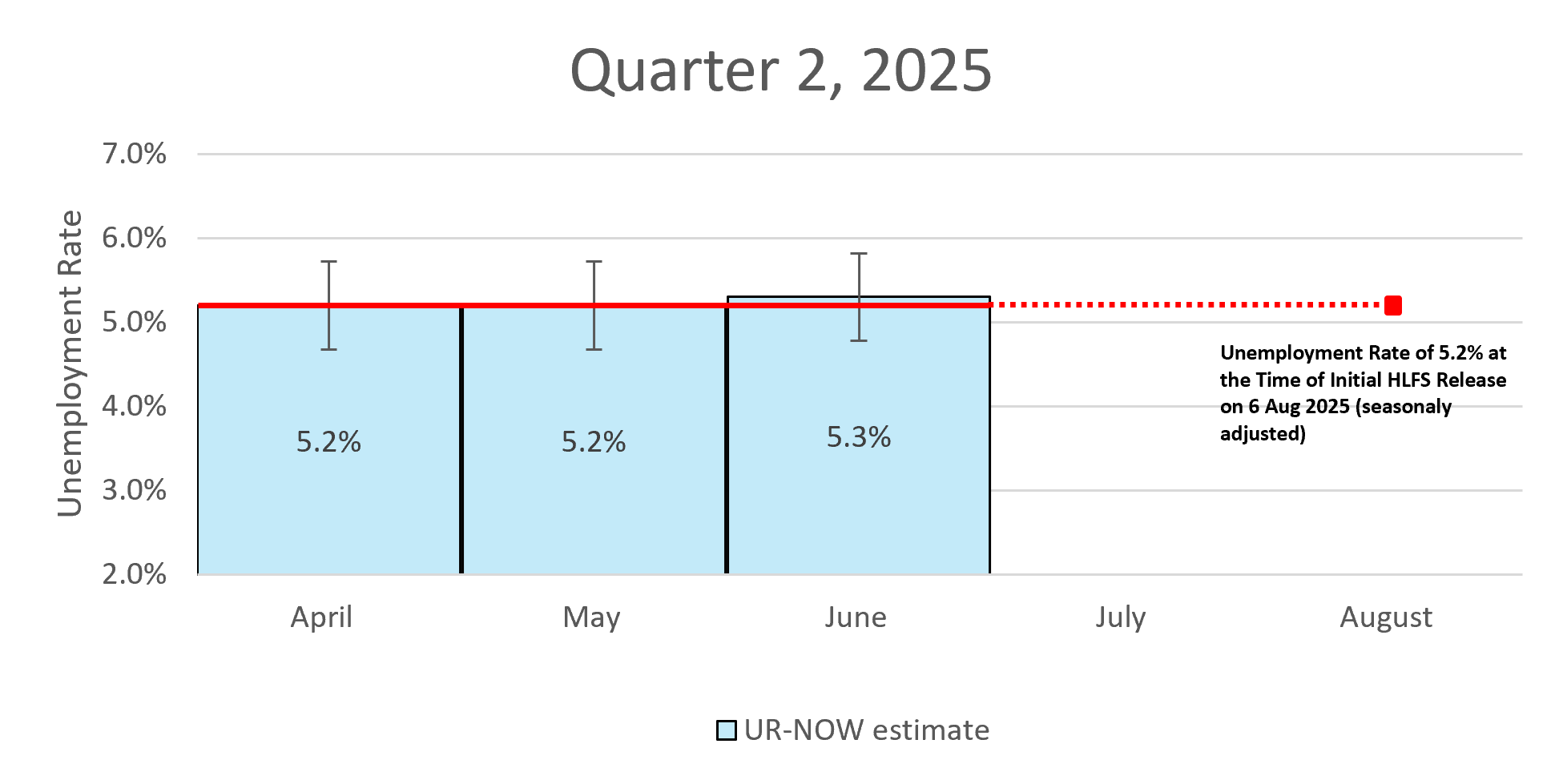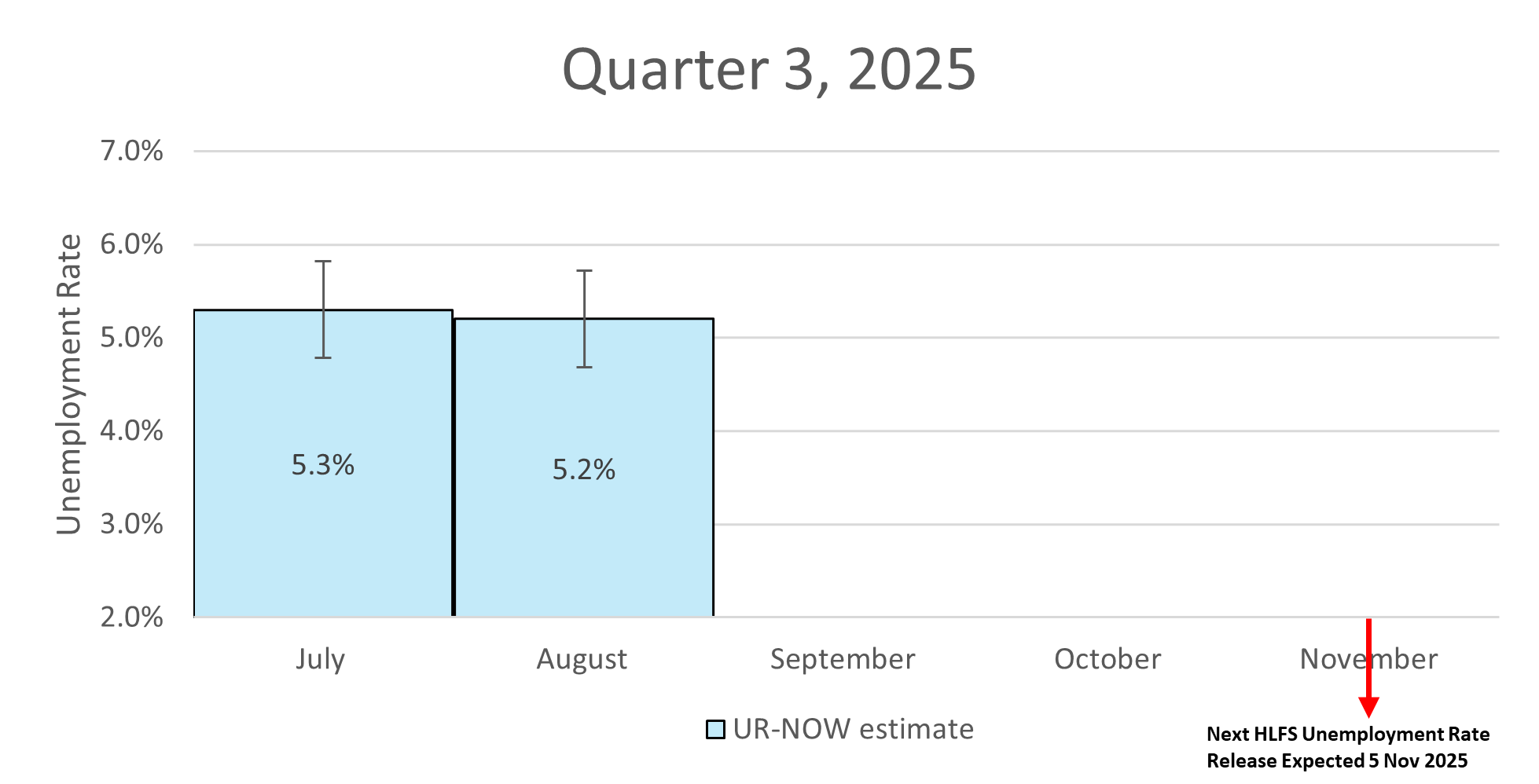Nowcasting the current rate of unemployment using administrative data
The unemployment rate is an important economic and social indicator that is an input into decision making by government, the private sector, community, and individuals. There is a time lag in the availability of the indicator because it is based on a survey of households over the three months of each quarter, and the indicator is then published approximately 5 weeks after surveying has finished. The UR-NOW model utilises administrative data about the receipt of benefits and the number of filled jobs to predict or nowcast the headline unemployment rate for the current quarter. The aim is to provide more timely information about the unemployment rate, which is particularly important during times of increasing economic volatility and uncertainty.
UR-NOW predictions on the unemployment rate will appear on this webpage usually at the end of the first week of each month.
Recent Data: UR-NOW estimates and HLFS unemployment rate
The latest official, seasonally adjusted New Zealand unemployment rate for the quarter ending in June 2025 was 5.2%. This represents an increase of 0.6 percentage points from 4.6% just one year earlier, in June 2024.
There have been recent predictions of pending recessions in New Zealand and many other developed economies. We believe that our UR-Now model has the capability of providing early warnings of future downturns in our economy. The recent Monetary Policy Statement from the New Zealand Reserve Bank forecasts a continuing weakening in our labour market, with the unemployment rate predicted to reach a maximum of 5.2% in June 2025.
Our consensus results for the second quarter of this year of 5.2% accurately predicted the recently announced official unemployment rate. The model now predicts that the unemployment rate will stabilize at 5.2% in the third quarter of this year.


Quarter | Unemployment Rate at the Time of Initial HLFS Release (seasonally adjusted) | End of month date for nowcast | UR-NOW estimate |
|---|---|---|---|
March | 5.1% | January 2025 | 5.2% |
February 2025 | 5.1% | ||
March 2025 | 5.1% | ||
June | 5.2% | April 2025 | 5.2% |
May 2025 | 5.2% | ||
June 2025 | 5.3% | ||
September | - | July 2025 | 5.3% |
August 2025 | 5.2% | ||
September 2025 | - |
(Latest Updates: HLFS Update for Q2, 2025 (6 Aug 2025), UR-NOW Estimate for Aug 2025 (3 Sep 2025))
Previous years
Quarter | Unemployment Rate at the Time of Initial HLFS Release (seasonally adjusted) | End of month date for nowcast | UR-NOW estimate |
|---|---|---|---|
March 2021 | 4.7% | January 2021 | 4.9% |
February 2021 | 4.8% | ||
March 2021 | 4.8% | ||
June 2021 | 4.0% | April 2021 | 4.6% |
May 2021 | 4.7% | ||
June 2021 | 4.6% | ||
September 2021 | 3.4% | July 2021 | 3.9% |
August 2021 | 3.8% | ||
September 2021 | 3.8% | ||
December | 3.2% | October 2021 | 3.5% |
November 2021 | 3.5% | ||
December 2021 | 3.4% |
Quarter | Unemployment Rate at the Time of Initial HLFS Release (seasonally adjusted) | End of month date for nowcast | UR-NOW estimate |
|---|---|---|---|
March 2020 | 4.2% | January 2020 | 4.0% |
February 2020 | 4.0% | ||
March 2020 | 4.1% | ||
June 2020 | 4.0% | April 2020 | 5.1% |
May 2020 | 5.2% | ||
June 2020 | 4.9% | ||
September 2020 | 5.3% | July 2020 | 5.3% |
August 2020 | 5.3% | ||
September 2020 | 5.2% | ||
December 2020 | 4.9% | October 2020 | 5.4% |
November 2020 | 5.3% | ||
December 2020 | 5.3% |
Quarter | Unemployment Rate at the Time of Initial HLFS Release (seasonally adjusted) | End of month date for nowcast | UR-NOW estimate |
|---|---|---|---|
March 2022 | 3.2% | January 2022 | 3.1% |
February 2022 | 3.0% | ||
March 2022 | 3.1% | ||
June 2022 | 3.3% | April 2022 | 3.2% |
May 2022 | 3.3% | ||
June 2022 | 3.3% | ||
September 2022 | 3.3% | July 2022 | 3.2% |
August 2022 | 3.1% | ||
September 2022 | 3.1% | ||
December 2022 | 3.4% | October 2022 | 3.2% |
November 2022 | 3.2% | ||
December 2022 | 3.2% |
Quarter | Unemployment Rate at the Time of Initial HLFS Release (seasonally adjusted) | End of month date for nowcast | UR-NOW estimate |
|---|---|---|---|
March 2023 | 3.4% | January 2023 | 3.3% |
February 2023 | 3.3% | ||
March 2023 | 3.3% | ||
June 2023 | 3.6% | April 2023 | 3.4% |
May 2023 | 3.4% | ||
June 2023 | 3.4% | ||
September 2023 | 3.9% | July 2023 | 3.6% |
August 2023 | 3.6% | ||
September 2023 | 3.6% | ||
December 2023 | 4.0% | October 2023 | 3.9% |
November 2023 | 3.9% | ||
December 2023 | 4.0% |
Quarter | Unemployment Rate at the Time of Initial HLFS Release (seasonally adjusted) | End of month date for nowcast | UR-NOW estimate |
|---|---|---|---|
March 2024 | 4.3% | January 2024 | 4.0% |
February 2024 | 4.0% | ||
March 2024 | 4.0% | ||
June 2024 | 4.6% | April 2024 | 4.4% |
May 2024 | 4.4% | ||
June 2024 | 4.5% | ||
September 2024 | 4.8% | July 2024 | 4.8% |
August 2024 | 4.8% | ||
September 2024 | 4.8% | ||
December 2024 | 5.1% | October 2024 | 4.9% |
November 2024 | 5.0% | ||
December 2024 | 5.0% |
Authors
David Rea
Principal Advisor, Ministry of Social Development
Tim Maloney
Professor with the School of Social Sciences and Public Policy, Auckland University of Technology
Chief Economist at Ministry of Social Development
Academic profile
LinkedIn